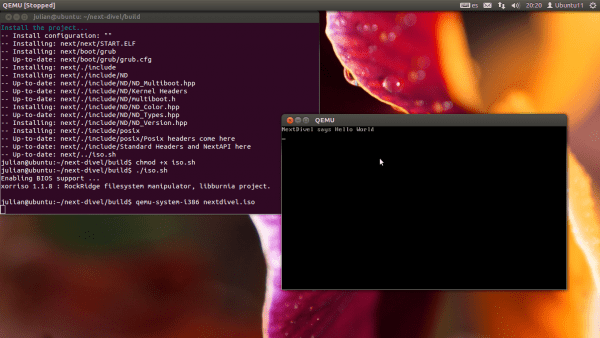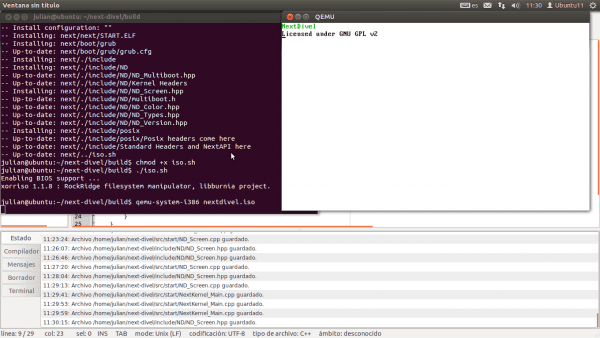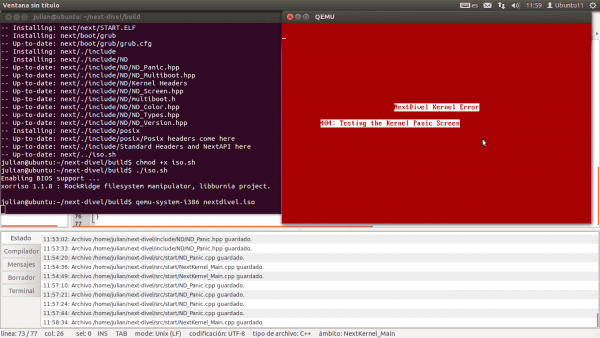欢迎阅读关于如何创建我们自己的操作系统的另一篇文章,在本例中为NextDivel。
如果我们回到 第一篇文章 在所有操作的最后,我们都应该想到这样的事情:
如果这是正确的,我们可以继续。 我将使用GitHub上的系统和结构(http://github.com/AdrianArroyoCalle/next-divel),因为它对我和您来说都比较舒适。 如您所见,文本是基本文本,没有吸引力。 看起来似乎与众不同。 但是俗话说,要尝尝颜色,在我们的操作系统中就会有颜色。 我们将要输入的第一个颜色将是定义VGA卡的颜色,它们是0:
- 黑色
- 蓝色
- 绿色
- 青色
- 罗霍
- 品红
- 褐色
- 浅灰色
- 格里斯·奥斯库罗(Gris oscuro)
- 浅蓝色
- 浅绿色
- 青色清除
- 红灯
- 浅洋红色
- 浅褐色
- 目标
我们将在标头中定义这些颜色,以使其更方便使用,并可能在将来成为系统API的一部分。 因此,我们在NextDivel include中创建了文件ND_Colors.hpp。
#ifndef ND_COLOR_HPP
#define ND_COLOR_HPP
typedef enum ND_Color{
ND_COLOR_BLACK = 0,
ND_COLOR_BLUE = 1,
ND_COLOR_GREEN = 2,
ND_COLOR_CYAN = 3,
ND_COLOR_RED = 4,
ND_COLOR_MAGENTA = 5,
ND_COLOR_BROWN = 6,
ND_COLOR_LIGHT_GREY = 7,
ND_COLOR_DARK_GREY = 8,
ND_COLOR_LIGHT_BLUE = 9,
ND_COLOR_LIGHT_GREEN = 10,
ND_COLOR_LIGHT_CYAN = 11,
ND_COLOR_LIGHT_RED = 12,
ND_COLOR_LIGHT_MAGENTA = 13,
ND_COLOR_LIGHT_BROWN = 14,
ND_COLOR_WHITE = 15
} ND_Color;
#endif
同时,我们将定义新的函数以更舒适的方式在屏幕上编写(不,我们还没有实现printf,我知道您想要它)。 我们将为一组与屏幕相关的功能(ND_Screen.cpp和ND_Screen.hpp)创建一个文件及其头。 在其中,我们将创建函数以:更改字母和背景的颜色,编写句子和字母,清洁屏幕并在屏幕上四处移动。 我们继续使用VGA屏幕,但现在我们将使用一些字节来显示颜色。 ND_Screen.cpp看起来像:
/**
* @file ND_Screen.cpp
* @author Adrián Arroyo Calle
* @brief Implements four easy functions for write strings directly
*/
#include <ND_Types.hpp>
#include <ND_Color.hpp>
#include <ND_Screen.hpp>
uint16_t *vidmem= (uint16_t *)0xB8000;
ND_Color backColour = ND_COLOR_BLACK;
ND_Color foreColour = ND_COLOR_WHITE;
uint8_t cursor_x = 0;
uint8_t cursor_y = 0;
/**
* @brief Gets the current color
* @param side The side to get the color
* */
ND_Color ND::Screen::GetColor(ND_SIDE side)
{
if(side==ND_SIDE_BACKGROUND){
return backColour;
}else{
return foreColour;
}
}
/**
* @brief Sets the color to a screen side
* @param side The side to set colour
* @param colour The new colour
* @see GetColor
* */
void ND::Screen::SetColor(ND_SIDE side, ND_Color colour)
{
if(side==ND_SIDE_BACKGROUND)
{
backColour=colour;
}else{
foreColour=colour;
}
}
/**
* @brief Puts the char on screen
* @param c The character to write
* */
void ND::Screen::PutChar(char c)
{
uint8_t attributeByte = (backColour << 4) | (foreColour & 0x0F);
uint16_t attribute = attributeByte << 8; uint16_t *location; if (c == 0x08 && cursor_x) { cursor_x--; }else if(c == '\r') { cursor_x=0; }else if(c == '\n') { cursor_x=0; cursor_y=1; } if(c >= ' ') /* Printable character */
{
location = vidmem + (cursor_y*80 + cursor_x);
*location = c | attribute;
cursor_x++;
}
if(cursor_x >= 80) /* New line, please*/
{
cursor_x = 0;
cursor_y++;
}
/* Scroll if needed*/
uint8_t attributeByte2 = (0 /*black*/ << 4) | (15 /*white*/ & 0x0F);
uint16_t blank = 0x20 /* space */ | (attributeByte2 << 8); if(cursor_y >= 25)
{
int i;
for (i = 0*80; i < 24*80; i++)
{
vidmem[i] = vidmem[i+80];
}
// The last line should now be blank. Do this by writing
// 80 spaces to it.
for (i = 24*80; i < 25*80; i++)
{
vidmem[i] = blank;
}
// The cursor should now be on the last line.
cursor_y = 24;
}
}
/**
* @brief Puts a complete string to screen
* @param str The string to write
* */
void ND::Screen::PutString(const char* str)
{
int i=0;
while(str[i])
{
ND::Screen::PutChar(str[i++]);
}
}
/**
* @brief Cleans the screen with a color
* @param colour The colour to fill the screen
* */
void ND::Screen::Clear(ND_Color colour)
{
uint8_t attributeByte = (colour /*background*/ << 4) | (15 /*white - foreground*/ & 0x0F);
uint16_t blank = 0x20 /* space */ | (attributeByte << 8);
int i;
for (i = 0; i < 80*25; i++)
{
vidmem[i] = blank;
}
cursor_x = 0;
cursor_y = 0;
}
/**
* @brief Sets the cursor via software
* @param x The position of X
* @param y The position of y
* */
void ND::Screen::SetCursor(uint8_t x, uint8_t y)
{
cursor_x=x;
cursor_y=y;
}
标头将是非常基本的,因此我不在这里包括,而是突出显示ND_SIDE类型的定义
typedef enum ND_SIDE{
ND_SIDE_BACKGROUND,
ND_SIDE_FOREGROUND
} ND_SIDE;
还要提一下,我们使用了 ND_Types.hpp 头,该头基于 char 和 int 定义了 uint8_t、uint16_t 等的一些基本类型。实际上这个标头是 C99 标准中的标头,事实上我的 ND_Types.hpp 是该文件的复制/粘贴 desde Linux,所以你可以交换它们并且不会发生任何事情(只有定义,没有函数)。
为了测试该代码是否有效,我们将修改内核的C入口点:
ND::Screen::Clear(ND_COLOR_WHITE);
ND::Screen::SetColor(ND_SIDE_BACKGROUND,ND_COLOR_WHITE);
ND::Screen::SetColor(ND_SIDE_FOREGROUND,ND_COLOR_GREEN);
ND::Screen::PutString("NextDivel\n");
ND::Screen::SetColor(ND_SIDE_FOREGROUND,ND_COLOR_BLACK);
ND::Screen::PutString("Licensed under GNU GPL v2");
如果我们按照以下步骤操作,我们将获得此结果
由于我们已经创建了这些功能,因此我们可以开始制作小型GUI,例如每次出现不可恢复的错误时都会显示的内核崩溃。 像这样:
而这个小小的GUI我们仅通过以下功能实现了它:
void ND::Panic::Show(const char* error)
{
ND::Screen::Clear(ND_COLOR_RED);
ND::Screen::SetColor(ND_SIDE_BACKGROUND, ND_COLOR_WHITE);
ND::Screen::SetColor(ND_SIDE_FOREGROUND, ND_COLOR_RED);
ND::Screen::SetCursor(29,10); //(80-22)/2
ND::Screen::PutString("NextDivel Kernel Error\n");
ND::Screen::SetCursor(15,12);
ND::Screen::PutString(error);
}
而这里的职位。 我提醒您有关从0开始编译系统的说明:
git clone http://github.com/AdrianArroyoCalle/next-divel
cd next-divel
mkdir build && cd build
cmake ..
make
make DESTDIR=next install
chmod +x iso.sh
./iso.sh
qemu-system-i386 nextdivel.iso
我借此机会感谢您对第一篇文章的好评。



很好的朋友,即使如此,我还是牺牲了我对C ++代码的理解。
问候。
这些物品很棒。 再次引起了我对处理器性能低下的好奇。
也许如果我有时间的话,我将开始下一场比赛。
我已经很久没有发送文章了。 已经需要
好的,就是这样。
我一直想知道如何构建操作系统。
等待您的下一篇文章。 干杯
很棒的朋友!
我只有一个问题,有人可以向我传递此示例的C文件吗?
它总是在终端中向我发送错误